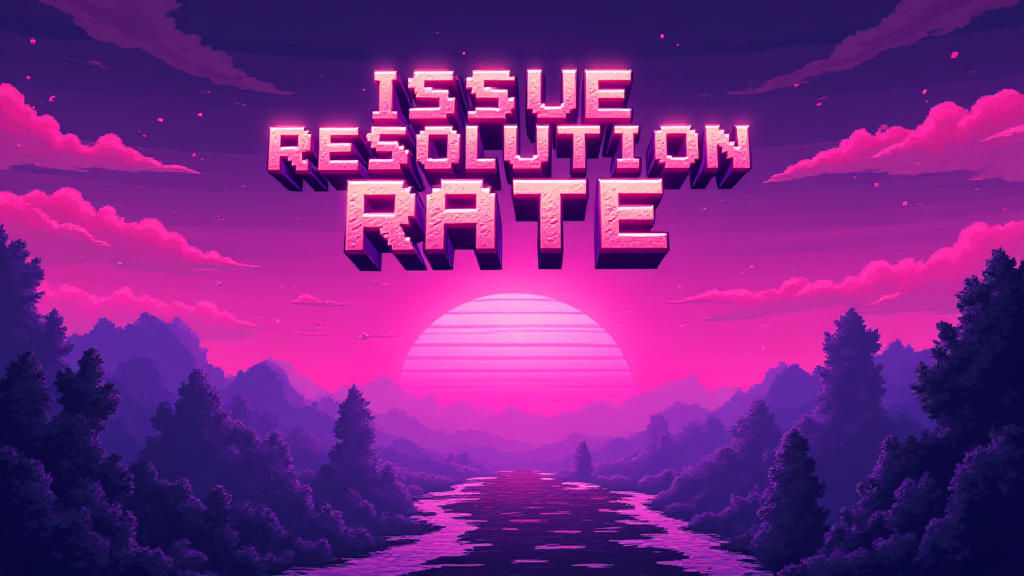Issue Resolution Rate: Key Metric for Customer Success

Published on: October 01, 2024
In the world of customer service and support, the Issue Resolution Rate (IRR) stands as a crucial metric that measures the efficiency and effectiveness of a company's problem-solving capabilities. This key performance indicator (KPI) provides valuable insights into how well an organization addresses and resolves customer issues, complaints, or inquiries.
Understanding Issue Resolution Rate 🔍
Issue Resolution Rate is typically expressed as a percentage and calculated using the following formula:
$IRR = \frac{Number\ of\ Issues\ Resolved}{Total\ Number\ of\ Issues\ Reported} \times 100$
A higher IRR indicates that a larger proportion of customer issues are being successfully addressed, which can lead to improved customer satisfaction and loyalty.
Why Issue Resolution Rate Matters 🎯
The importance of IRR in Sales, Marketing, and Revenue Operations cannot be overstated. Here's why:
- Customer Satisfaction: Quickly resolving issues leads to happier customers, increasing the likelihood of repeat business and positive word-of-mouth referrals.
- Operational Efficiency: A high IRR indicates that support teams are effectively handling customer concerns, potentially reducing costs associated with prolonged issue management.
- Brand Reputation: Consistently resolving issues promptly can enhance a company's reputation for excellent customer service.
- Revenue Impact: Efficient issue resolution can prevent customer churn and protect revenue streams.
Factors Influencing Issue Resolution Rate 🔧
Several factors can impact an organization's IRR:
- Support Team Skills: Well-trained staff with strong problem-solving abilities can improve IRR.
- Technology and Tools: Advanced ticketing systems and knowledge bases can streamline the resolution process.
- Issue Complexity: Some problems may be more challenging to resolve, affecting the overall IRR.
- Response Time: Faster initial responses often correlate with higher resolution rates.
- Escalation Procedures: Efficient escalation processes for complex issues can improve IRR.
Improving Issue Resolution Rate 📈
To enhance IRR, consider implementing the following strategies:
- Invest in comprehensive training programs for support staff.
- Implement a robust knowledge management system.
- Utilize AI and automation for routine inquiries.
- Regularly analyze common issues and develop standardized solutions.
- Set clear SLAs (Service Level Agreements) for different types of issues.
Issue Resolution Rate vs. Other Customer Service Metrics 📊
While IRR is crucial, it's essential to consider it alongside other metrics for a comprehensive view of customer service performance:
| Metric | Description | Relationship to IRR |
|---|---|---|
| First Contact Resolution (FCR) | Issues resolved in the first interaction | Contributes to higher IRR |
| Average Handle Time (AHT) | Average time to resolve an issue | May impact IRR if too high |
| Customer Satisfaction Score (CSAT) | Measure of customer happiness | Often correlates with high IRR |
| Net Promoter Score (NPS) | Likelihood of customer recommendation | Can be influenced by IRR |
Common Challenges in Improving Issue Resolution Rate 🚧
Organizations often face hurdles when trying to enhance their IRR:
- Resource Constraints: Limited staff or budget can hinder improvement efforts.
- Complex Product Ecosystems: Multiple products or services can complicate issue resolution.
- Changing Customer Expectations: Evolving demands for faster, more personalized support.
- Data Silos: Lack of integrated information across departments can slow resolution times.
By focusing on Issue Resolution Rate, organizations can significantly enhance their customer service performance, leading to improved satisfaction, loyalty, and ultimately, revenue growth. 💼💰
Questions to Consider for Your Sales or Marketing Stack:
- How does our current Issue Resolution Rate compare to industry benchmarks?
- What tools or technologies could we implement to improve our IRR?
- How can we better integrate IRR data with our CRM and marketing automation systems?
- Are there specific types of issues that consistently lower our IRR, and how can we address them?
- How can we leverage a high IRR in our marketing messages to differentiate ourselves from competitors?

















